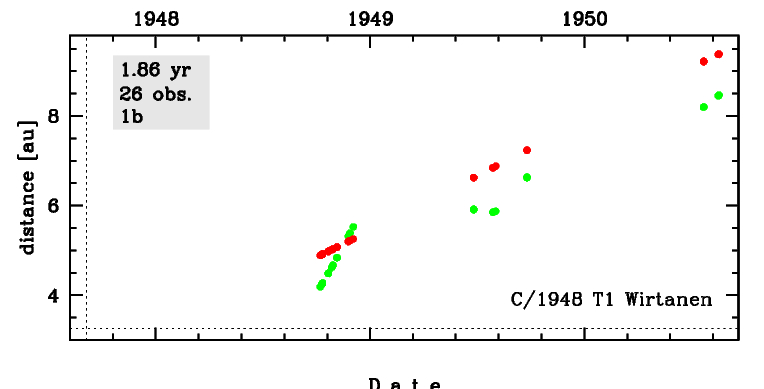C/1948 T1 Wirtanen
more info
Comet C/1948 T1 was discovered on 7 October 1948, about 13 months after perihelion passage and was last seen on 11 September 1950 [Kronk, Cometography: Volume 4].
This comet made its closest approach to the Earth on 26 October 1947 (2.44 au), that is one month after perihelion passage and almost one year before its discovery.
Solution given here is based on data spanning over 1.86 yr on postperihelion leg of orbit in a range of heliocentric distances from 4.89 au to 9.38 au.
This Oort spike comet suffered small planetary perturbations during its passage through the planetary zone that caused a bit tighter future orbit (see original and future barycentric orbits).
More details in Królikowska et al. 2014 andKrólikowska and Dybczyński 2017.
This comet made its closest approach to the Earth on 26 October 1947 (2.44 au), that is one month after perihelion passage and almost one year before its discovery.
Solution given here is based on data spanning over 1.86 yr on postperihelion leg of orbit in a range of heliocentric distances from 4.89 au to 9.38 au.
This Oort spike comet suffered small planetary perturbations during its passage through the planetary zone that caused a bit tighter future orbit (see original and future barycentric orbits).
More details in Królikowska et al. 2014 andKrólikowska and Dybczyński 2017.
| solution description | ||
|---|---|---|
| number of observations | 26 | |
| data interval | 1948 10 07 – 1950 08 17 | |
| data type | observed only after perihelion (POST) | |
| data arc selection | entire data set (STD) | |
| range of heliocentric distances | 4.89 au – 9.38au | |
| detectability of NG effects in the comet's motion | NG effects not determinable | |
| type of model of motion | GR - gravitational orbit | |
| data weighting | NO | |
| number of residuals | 52 | |
| RMS [arcseconds] | 0.94 | |
| orbit quality class | 1b | |
| next orbit statistics, both Galactic and stellar perturbations were taken into account | ||
|---|---|---|
| no. of returning VCs in the swarm | 5001 | * |
| no. of escaping VCs in the swarm | 0 | |
| no. of hyperbolas among escaping VCs in the swarm | 0 | |
| next reciprocal semi-major axis [10-6 au-1] | 212.36 – 225.17 – 238.10 | |
| next perihelion distance [au] | 3.2672 – 3.2695 – 3.2711 | |
| next aphelion distance [103 au] | 8.4 – 8.88 – 9.41 | |
| time interval to next perihelion [Myr] | 0.272 – 0.295 – 0.323 | |
| percentage of VCs with qnext < 10 | 100 | |
| next_g orbit statistics, here only the Galactic tide has been included | ||
|---|---|---|
| no. of returning VCs in the swarm | 5001 | * |
| no. of escaping VCs in the swarm | 0 | |
| no. of hyperbolas among escaping VCs in the swarm | 0 | |
| next reciprocal semi-major axis [10-6 au-1] | 212.35 – 225.17 – 238.09 | |
| next perihelion distance [au] | 3.2576 – 3.2599 – 3.2617 | |
| next aphelion distance [103 au] | 8.4 – 8.88 – 9.41 | |
| time interval to next perihelion [Myr] | 0.272 – 0.295 – 0.323 | |
| percentage of VCs with qnext < 10 | 100 | |
